Introduction to eBikes
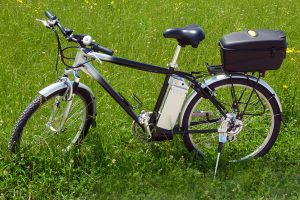
You may have already heard about eBikes. And many people have seen it used. Maybe you have an eBike. What exactly is an eBike? According to Wikipedia, “an e-bike, An electric bicycle is a motorized bicycle with an integrated electric motor used to assist driving.” Just like a regular bike, these electric bikes also have pedals.
But many people confuse electric motorcycles with electric bikes. In fact, they are not one but two. Electric bikes have pedals but electric motorbikes do not have pedals. Also, if you want to drive electric motorcycles on the road, you need to have a license like other vehicles. But electric bikes don’t need that. They are also capable of driving on the road like other normal bikes.
Why eBikes?

Currently, many people around the world use various means of transportation for their convenience. Means of transportation such as cars, buses, and trains have become increasingly popular. We all know that gasoline and diesel are needed for each of these means of transportation. And another thing we also know is that these fuels belong to non-renewable energy. This is the biggest challenge for all of us when we use these means of transportation!
Also, another problem caused by these types of fuel-burning means of transport is the increase in environmental pollution. Due to these various unfavorable conditions, many developed countries are turning to other modes of transportation, especially those that consume less fuel. For this, they are more inclined to get used to using bicycles. In America, Canada, and many European countries, bicycles are used both in rural and urban areas. Using these bicycles is more suitable for the fuel problem, reducing environmental pollution and reducing traffic congestion in the suburbs.
We all know that cycling is a good exercise to maintain health. But for those who go to work daily and have to travel a long distance, cycling is not as easy as you think. So, for the convenience of such people, the e-bike was created to improve the bike and run on electricity. These electric bikes can be used to travel considerable distances without much effort. Another advantage is that they can be charged with normal electricity at home. Many people have become accustomed to electric bicycles after previously using ordinary bicycles because they can be charged for a few hours.
History of eBikes

Are these e-bikes really new? not really. The history of these e-bikes dates back to the 19th century. In the 1880s and 1890s, it is reported that the first electric bikes were produced with patents in America and France.
- American inventor Ogden Bolton Jr. has developed the first electric bicycle in 1895. He has even obtained a patent for this battery-operated device. Here he has set it up so that it can be driven by a hub motor attached to the rear wheel of the bicycle using a 10-volt battery to get power.
- Then in 1897, Hosea W. Libbey invented a bicycle with two electric motors, and John Schnepf invented an electric bike powered by a motor connected to the roller wheel. That’s how people started thinking about producing electric bicycles from that time.
- Mathew J. Steffens developed and patented an electric bike with a driving belt in 1899.
- In 1992, Michael Kutter and Velocity City teamed up to create electric bikes called pedelecs with pedal-assisted. Also known as the Dolphin Electric Bike, this was the forerunner of today’s electric bikes. This also managed to get a very good market attraction.
In this way, later in many countries of the world, electric bikes were released to the market by adding innovations by various companies.
How does this electric bike work?
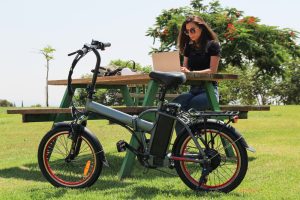
Now let’s see how this electric bike works. For this, we need to talk about the specific accessories of an electric bike. There are a few special parts and a number of accessory components that make up an electric bicycle. We can identify them as follows.
- Battery Pack
- Motor
- Controller
Battery Pack

The most valuable part of an e-bike is through which the power required by the bike is provided. In the early e-bikes, these batteries consisted of lead acid, nickel cadmium, or NiMH. But due to the defects in such batteries, the e-bikes used today have lithium-ion batteries. Due to this, it has been possible to increase the running life of electric bikes. Most electric bikes have 36-volt or 48-volt batteries. But there are cases where the batteries are available as the smallest voltage value is 24 and the highest is 72 volts.
When attaching this battery pack to the bike, it often adds a strange beauty to the exterior of the bike. These batteries are mounted on the downtube inside the triangle, or on a rear carrier rack of the bike.
Motor

The motor connected to the bike is what pushes the bike forward, that is, it drives. The electrical power from the battery provides the mechanical power required for the motor. Most electric bikes have this motor embedded in the hub of the front or rear wheel. And this motor can vary depending on factors such as the size of the bike, and the amount of electricity supplied by the battery.
The number of times the motor rotates per minute or rpm (Round Per Minute) varies depending on the voltage supplied by the battery. That value determines the maximum speed at which the bike can be driven. For example, if the motor reads 10 rpm/V, it means that a maximum value of 120 rpm can be obtained from a 12V battery pack.
Controller
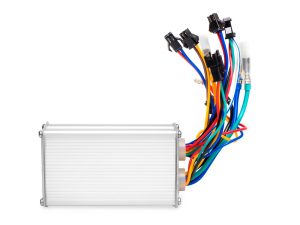
Finally, we can call this controller another main component of an electric bike. This is what connects the battery pack and the motor. This controller performs two main functions. First, the DC voltage in the battery pack is converted into an AC voltage for the windings of the motor. Second, it controls the voltage going from the battery to the motor. It happens according to the responses of the bike rider like sensors & throttle signals.
In this type of motor controller, there is an electronic circuit consisting of parts such as 6 power metal-oxide-semiconductors, large capacitors, and connectors. Therefore, this circuit board is stored in an aluminum box. In this type of motor controller, there is an electronic circuit consisting of parts such as 6 power metal-oxide-semiconductors, large capacitors, and connectors. Therefore, this circuit board is stored in an aluminum box. And this controller is located in the bike’s hub motor or inside the battery mounting cradle.
In addition to the main parts that we talked about, let’s now discuss some other special parts of an electric bike.
Throttle
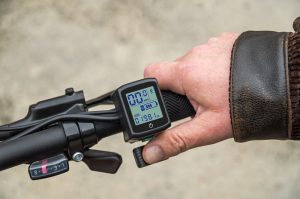
The throttle is the part similar to the handle of normal bicycles. But we have the ability to press it as much as we want, just like the accelerator in a motorcycle.
Pedal Assist System sensor or Torque sensor
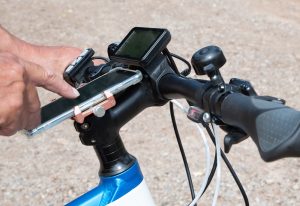
These sensors provide the necessary signal as you paddle the bike. In order for the motor to work properly according to the signals given by the controller, these sensors must work properly.
eBrakes
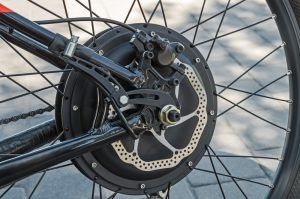
Ebrake sensors can be called another part of electric bikes. We know that in normal bikes the brakes are actuated through the actuation of a cable. But in these bikes, the brakes are activated through sensors. As soon as you apply the brake levers, the signal sent to the motor through the sensors reduces the power. Then the brakes are applied to slow down the bike.
Display
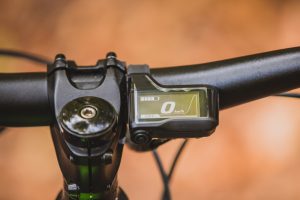
Of course, this is not a device that was in electric bikes in the early days. This special screen is included in the modern electric bikes produced today. In the early days, there was only a small indicator that showed the amount of charge in the electric battery.
But currently, the display mounted on the handle of the bike displays a lot of important information for the bike rider in addition to the battery level. Important information such as the distance traveled by bike, how far the battery can go, the speed at the relevant moment, the time it takes to get to a specific place can be taken care of with a simple display like this. In addition to this, modern bikes have been manufactured in such a way that the phone can be connected via Bluetooth and even make calls, display messages, etc.
Now you have a rough idea of how these electric bikes work. The motor runs on the power provided by the charged batteries. The motor provides the necessary power to the pedals of the bike and the bike has the ability to increase or decrease the speed according to the needs of the rider. It happens according to the responses of the sensors we mentioned earlier.
How do you ride an electric bike?

An electric bike weighs a little more than a regular bike. The reason is because of the special parts like the battery and the motor. Most electric bikes are equipped with weights ranging from 4 kg to 8 kg. Perhaps those values can be increased depending on the nature of the metal used for the production of the bicycle.
So handling such a bike may be difficult at first, but once you get used to it, it will become normal. And you will not feel any discomfort while riding it. That’s because we get power from the motor without consuming our energy like normal bicycles.
First, you turn on the motor to prepare to ride it and select the required assistance level from the controller. Then pedal. Then the motor will gradually give you acceleration. Through the throttle, you can control it and move easily. In short, you can even climb a mountain without getting tired.
The most important thing you need to know when riding electric bikes is how far the battery can easily go. Most electric bikes can travel between 20 and 100 miles on a full charge. It varies according to the capacity of the battery we use. Then when the battery charge is over, we can’t go any further. No. It won’t happen. This is a bicycle. That means we have the ability to pedal and drive with our own power like a normal bicycle.
Types of electric bikes
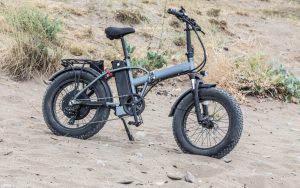
We can talk mainly about two types of electric bikes. The most common types of electric bikes are hybrids and mountain bikes.
- Electric hybrid bikes – These bikes are lightweight. Equipped with a small battery pack, motor, and puncture-resistant tires. These are for normal driving around the city, such as, going to work, going to school, going shopping, etc.
- Electric mountain bikes – Electric mountain bikes are equipped with a relatively large motor and a battery that can store a large amount of charge, which gives the bike a high torque and gives you the opportunity to go off-road easily.
Advantages & Disadvantages of e-Bikes

Next, let’s see what are the benefits or advantages, of e-bikes.
- We can mention environmental friendliness as the most advantageous situation here. That is to say, because it is powered by electricity, it does not produce harmful emissions to the environment like wasting fuel.
- Health and keeping active are other benefits of e-bikes. Although your legs are not worked here like in a normal bicycle, the whole body with arms, shoulders, and core is worked, so the body gets a good workout.
- Using Motor and effort to ride. Because of electric bikes, you might think that this would be self-moved. But it is not so. By pedaling you with the motor, the bike moves forward.
- Another advantage of these electric bikes is speed. We cannot travel at high speed with a normal bicycle. But since these bikes have speeds from 20 to 100 miles per hour, our needs can be met well.
- Good battery life. Recharging takes between 3 and 8 hours of time depending on the battery and charger. Also, even if the battery is not charged while you are traveling, you can still ride like a regular bike.
- Ease of climbing. You can’t easily ride an ordinary bike up a hill, right? But thanks to the battery in electric bikes, the task can be easily done by its’ charging.
We are talking about the advantages of e-bikes. It is good and bad in everything. So these e-bikes also have a bad side. Now let’s see what they are.
- High cost. Compared to the price of a regular bike in the market, buying an e-bike is more expensive. It is cheaper than buying another electric vehicle, but it’s high cost than a regular bike.
- Maintenance should be done very well. Unlike a regular bike, it needs to be cleaned frequently because of the electric devices. If not, the efficiency of those devices may decrease.
- Since e-bikes are quite heavy, they are less easy to carry around. Also, if the battery charge is lost during your trip, you will have to use some effort to ride.
- Compared to the time it takes to charge the battery, you will be able to ride the bike in less time. For example, if you charge the battery for 5 hours, it can only run for about 3 hours.
- Due to the high demand for e-bikes around the world, many countries have even implemented transport rules for e-bikes. This is why in some countries an e-bike has to be registered in order to put it on the road.
Three classes of E-bikes

We mentioned to you earlier that many countries have made various rules and regulations for e-bikes. According to those rules, e-bikes are classified into three main categories, that is, classes.
Class 1 – e-bikes with pedal-assist only, there is no throttle, and have a maximum controlled speed of 20 mph.
Class 2 – eBikes with a maximum speed of 20 mph, but they are throttle-supported.
Class 3 – electrically supported pedelec that has a speedometer and can offer motor power up to 28 mph of maximum speed. There are available with or without a throttle.
In each of these classes, the power of the motor is limited to 1 horsepower. (750W)
Now let us explain these three classes separately.
Class 1 e-bikes
- The maximum speed limit for these types of bikes is 20 mph.
- The motor of these works only when the rider pedals the pedal.
- It does not require you to pedal hard. You can easily do it.
- The pedal motor in these bikes is called a pedelec.
- Bikes of this class can be ridden on normal bike paths and bike lanes.
- Examples of Class 1 e-bikes are, Propella, Tern GSD S10, and Cannondale Quick Neo SL
Class 2 e-bikes
- The maximum speed of these bikes is 20 miles per hour and they have throttles that work even if you don’t pedal.
- In this kind of e-bike, the pedals are electrically actuated during throttles.
- They can also travel on the roads reserved for bicycles and are not suitable for mountain climbing and off-road driving.
- Examples of these types of bikes are, Wing Freedom 2 and X (with optional throttle), Super73 S1, Aventon Pace 350
Class 3 e-bikes
- It is faster than the previous two modes. Accordingly, these bikes can run at a speed of 28 miles per hour.
- This is also pedal-assisted so you can move at the desired speed.
- Bikes of this class also have the ability to go in road lanes or bike-only lanes.
- But you can’t ride these bikes in busy lanes outside of the roads like inside parks.
- As examples of bikes in this class are, Specialized Turbo Vado SL Equipped, Aventon Pace 500, Trek Domane+ HP
Thus, you now understand that there are several things that we need to take care of when using an e-bike that works with this new technology than using a regular bike or motorcycle. Therefore, according to your needs, it will bring you more convenience to choose the most suitable bike subject to the rules and regulations in force in the country where you live.

Good write..